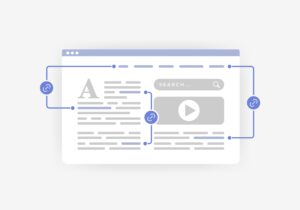
How to Use Internal Linking to Boost Page Authority
High-quality content isn’t the only thing that matters when it comes to SEO. Inbound links are also a major element of a successful SEO strategy. Many digital marketers treat a linking strategy like an afterthought, when it actually requires a proactive and intentional approach. If you have questions on precisely how to leverage internal linking for all-important page authority, keep reading.
What is Internal Linking? 
Internal linking is the process of using hyperlinks to link one page on your site to another page on your website. The strategy not only keeps users on your site for longer, it boosts SEO authority. That’s because in this way you can share the authority of your other best content with your new efforts.
To provide more context, every time you create an internal link for a page, you signal to search engines like Google that another page on your website is more important. Internal links as well as links from other high-quality sources are known to improve your overall search engine authority and improve rankings over time.
Establishing an Internal Link Structure
Start by thinking about what is most important on your website or blog. If there is an established page that you feel strongly about or that tends to get a lot of traffic, it’s essential to think about how to signal to search engines the importance of a page. This is where an internal linking strategy comes into play.
Think of the ways that a search engine understands the value of an internal link. It involves looking at how many pages on your website link to that particular content, and how they link to it. If most of your web pages link to something, it must be important. Good examples are your homepage, your blog’s home page, or key service pages. In that vein, if the only link to your blog is from an “About us” section with nothing from the home page or other pages, that sends a strong signal to search engines that your blog isn’t very important and shouldn’t have much authority. But, if that link to your blog is on several pages and the main navigation of your website, search engines know to treat it like one of your top pages.
This is true for more specific pages such as a specific blog or service page, as well as larger pages. If you have a more in-depth blog that gets a lot of views, you can link phrases in follow-up blog posts to prove to search engines that this page is highly valuable to visitors.
To leverage internal linking properly, start by performing an audit of your website’s main pages and how you might interlink between them. As you write blog posts, you should look for ways to interlink to other blog posts and pages in a way that feels natural and organic.
Three Tactics for Making the Most of Internal Linking 
An effective internal linking strategy is proactive and involves some strategy. It’s not a matter of just plugging in other links to your web content as often as possible. Follow these steps to develop an internal linking strategy that helps with SEO.
- Perform an audit of your website. Begin by making a list of each page on your main navigation. Document each page and then what links are on each of those major pages. Doing this will help you to understand the links that you already have between each section of your site, and the ways that you’ve linked it together already. Sometimes the best way to do this is to lay things out visually. Try using a white board or a computer program to display each of your pages and how they are linked.
- Consider the topics that you write most about. If you write frequently about something, chances are you might want another dedicated page on your website or blog. A good example is a landing page where visitors can download a longer white paper or sign up for a webinar. Each post that you create on the topic should link to the authoritative page on the subject and be optimized for conversions. If your landing page has a call-to-action (and it should), effective use of internal linking will drive more leads over time. Next think about where that page lives in your navigation, and if it might be more effective to link to from your homepage. For example, if there are important pieces that explain answers to common legal questions for new visitors, that would make a good blog post that deserves more promotion across various aspects of your site.
- Consider other pages that could link to your higher-ranking pages. If there is a page related to the topics that you frequently write about, make sure each of your new blog posts about that topic reference the original page and link to it. For example, if one of your most popular topics is child custody disputes, then you likely have (or should have) an overarching landing page that shares broad information on child custody disputes along with a CTA and other relevant links. Blogs such as “How to Navigate Child Custody Disputes” or “5 Key Things to Bring to Your Child Custody Hearing” should all link back to that original child custody dispute landing page.
Takeaway:
Internal linking is a crucial aspect of SEO because it helps search engines to understand the structure and relevance of your website’s content. When you link different pages within your website, you create a network of connections for search engines to follow, thereby allowing them to discover and index more of your pages. Plus, internal linking is helpful for website users and can improve overall website experience and performance. Follow these tips to make the most of an internal linking strategy. For more SEO tips, try our free SEO audit. Our website SEO analysis report will help you find and fix on-site issues and boost SEO-optimization.
Are you ready to get started generating new, qualified leads?
Contact us to get started and let us help you energize your digital marketing and business development efforts.
Contact Us


